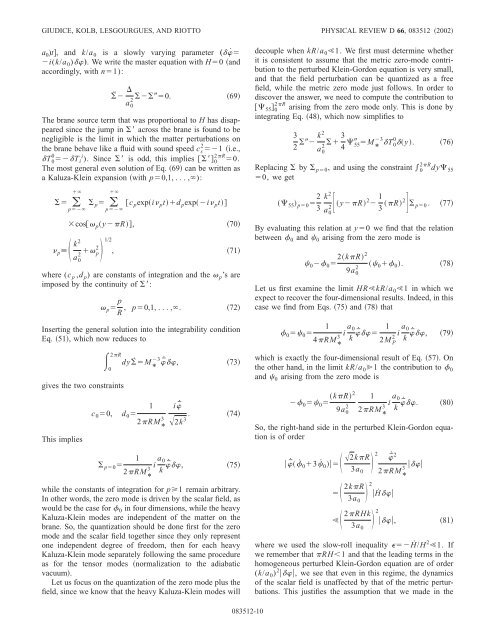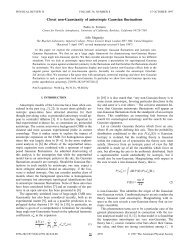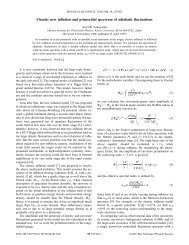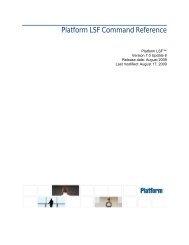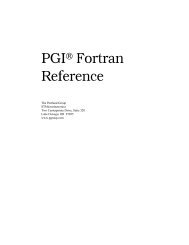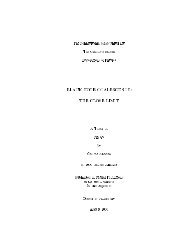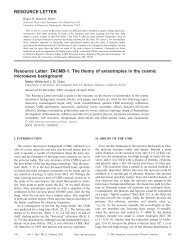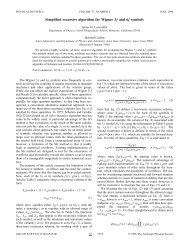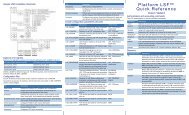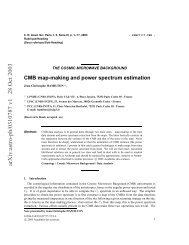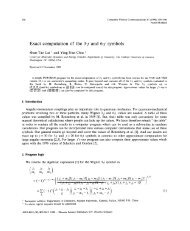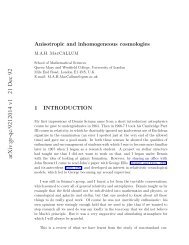Transdimensional physics and inflation - American Physical Society
Transdimensional physics and inflation - American Physical Society
Transdimensional physics and inflation - American Physical Society
Create successful ePaper yourself
Turn your PDF publications into a flip-book with our unique Google optimized e-Paper software.
GIUDICE, KOLB, LESGOURGUES, AND RIOTTO<br />
a 0 )t, <strong>and</strong> k/a 0 is a slowly varying parameter „˙ <br />
i(k/a 0 )…. We write the master equation with H0 <strong>and</strong><br />
accordingly, with n1):<br />
¨ a 0<br />
2 0.<br />
69<br />
The brane source term that was proportional to H has disappeared<br />
since the jump in across the brane is found to be<br />
negligible is the limit in which the matter perturbations on<br />
the brane behave like a fluid with sound speed c s 2 1 i.e.,<br />
T 0 0 T i i ). Since is odd, this implies 0 2R 0.<br />
The most general even solution of Eq. 69 can be written as<br />
a Kaluza-Klein expansion with p0,1,...,):<br />
<br />
<br />
p<br />
<br />
p k2<br />
<br />
p <br />
p<br />
c p expi p td p expi p t<br />
cos p 2<br />
yR,<br />
1/2<br />
2<br />
a p<br />
0<br />
70<br />
, 71<br />
where (c p ,d p ) are constants of integration <strong>and</strong> the p ’s are<br />
imposed by the continuity of :<br />
p p , p0,1,...,. 72<br />
R<br />
Inserting the general solution into the integrability condition<br />
Eq. 51, which now reduces to<br />
2R<br />
dy˙ M 3 ¯˙ ,<br />
73<br />
0 *<br />
gives the two constraints<br />
This implies<br />
c 0 0, d 0 1<br />
2RM *<br />
3<br />
i¯˙<br />
2k<br />
3 .<br />
p0 1<br />
2RM *<br />
3 i a 0<br />
k ¯˙ ,<br />
74<br />
75<br />
while the constants of integration for p1 remain arbitrary.<br />
In other words, the zero mode is driven by the scalar field, as<br />
would be the case for 0 in four dimensions, while the heavy<br />
Kaluza-Klein modes are independent of the matter on the<br />
brane. So, the quantization should be done first for the zero<br />
mode <strong>and</strong> the scalar field together since they only represent<br />
one independent degree of freedom, then for each heavy<br />
Kaluza-Klein mode separately following the same procedure<br />
as for the tensor modes normalization to the adiabatic<br />
vacuum.<br />
Let us focus on the quantization of the zero mode plus the<br />
field, since we know that the heavy Kaluza-Klein modes will<br />
decouple when kR/a 0 1. We first must determine whether<br />
it is consistent to assume that the metric zero-mode contribution<br />
to the perturbed Klein-Gordon equation is very small,<br />
<strong>and</strong> that the field perturbation can be quantized as a free<br />
field, while the metric zero mode just follows. In order to<br />
discover the answer, we need to compute the contribution to<br />
55 0 2R arising from the zero mode only. This is done by<br />
integrating Eq. 48, which now simplifies to<br />
3<br />
2<br />
PHYSICAL REVIEW D 66, 083512 2002<br />
k2<br />
<br />
a 3 2<br />
0<br />
4 55 M 3 T 0<br />
*<br />
0 y.<br />
76<br />
Replacing by p0 , <strong>and</strong> using the constraint 0 2R dy 55<br />
0, we get<br />
k 2<br />
55 p0 2 3 2 yR 2 1<br />
a 0<br />
3 R2 p0 .<br />
77<br />
By evaluating this relation at y0 we find that the relation<br />
between 0 <strong>and</strong> 0 arising from the zero mode is<br />
0 0 2kR2<br />
9a 0<br />
2<br />
0 0 . 78<br />
Let us first examine the limit HRkR/a 0 1 in which we<br />
expect to recover the four-dimensional results. Indeed, in this<br />
case we find from Eqs. 75 <strong>and</strong> 78 that<br />
0 0 1<br />
4RM *<br />
3 i a 0<br />
k ¯˙ <br />
1<br />
2M P<br />
2 i a 0<br />
k ¯˙ ,<br />
79<br />
which is exactly the four-dimensional result of Eq. 57. On<br />
the other h<strong>and</strong>, in the limit kR/a 0 1 the contribution to 0<br />
<strong>and</strong> 0 arising from the zero mode is<br />
0 0 kR2<br />
9a 0<br />
2<br />
1<br />
2RM *<br />
3 i a 0<br />
k ¯˙ .<br />
80<br />
So, the right-h<strong>and</strong> side in the perturbed Klein-Gordon equation<br />
is of order<br />
¯˙ ˙ 03˙ 0 2kR<br />
3a 0<br />
2kR<br />
3a 0<br />
2RHk<br />
3a 0<br />
2<br />
<br />
¯˙ 2<br />
2RM *<br />
3 <br />
2<br />
Ḣ<br />
2<br />
,<br />
81<br />
where we used the slow-roll inequality Ḣ/H 2 1. If<br />
we remember that RH1 <strong>and</strong> that the leading terms in the<br />
homogeneous perturbed Klein-Gordon equation are of order<br />
(k/a 0 ) 2 , we see that even in this regime, the dynamics<br />
of the scalar field is unaffected by that of the metric perturbations.<br />
This justifies the assumption that we made in the<br />
083512-10


